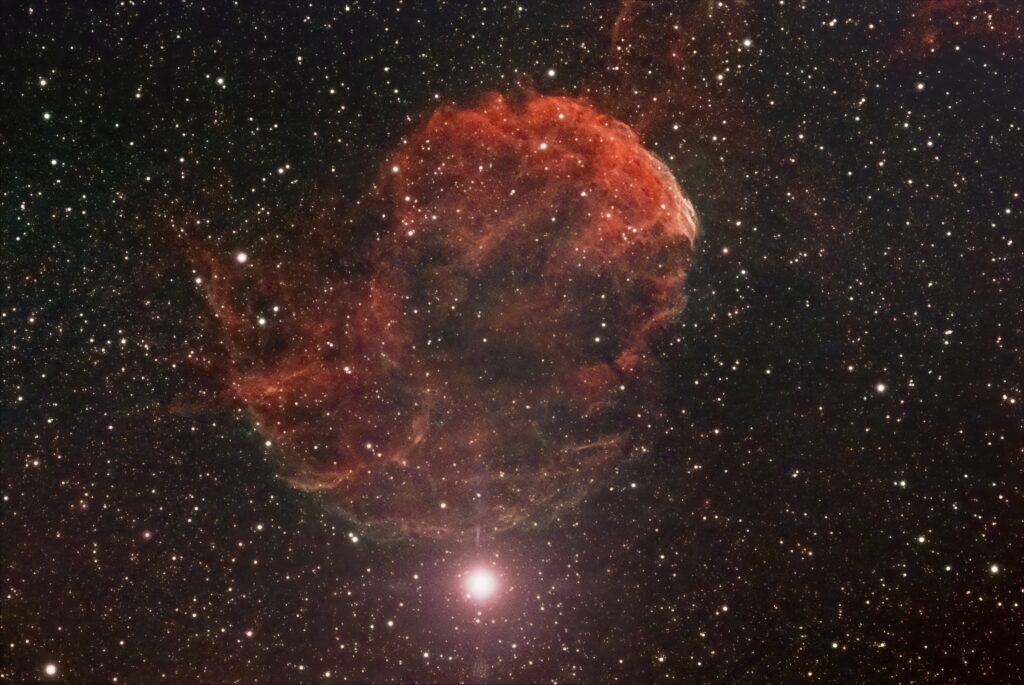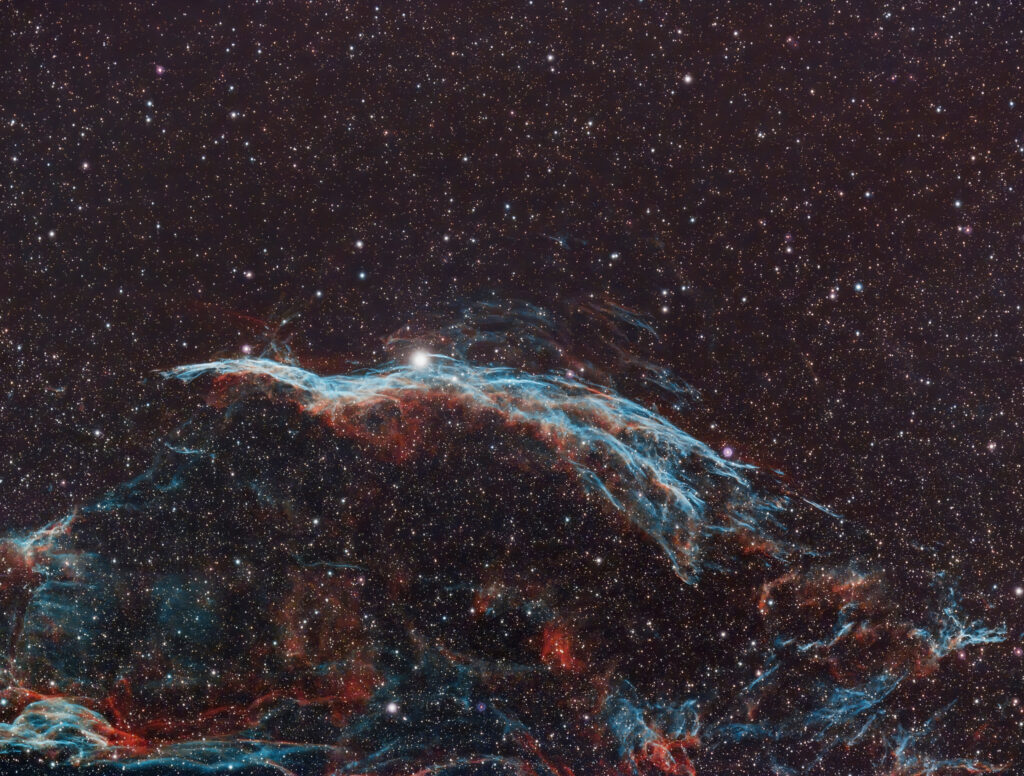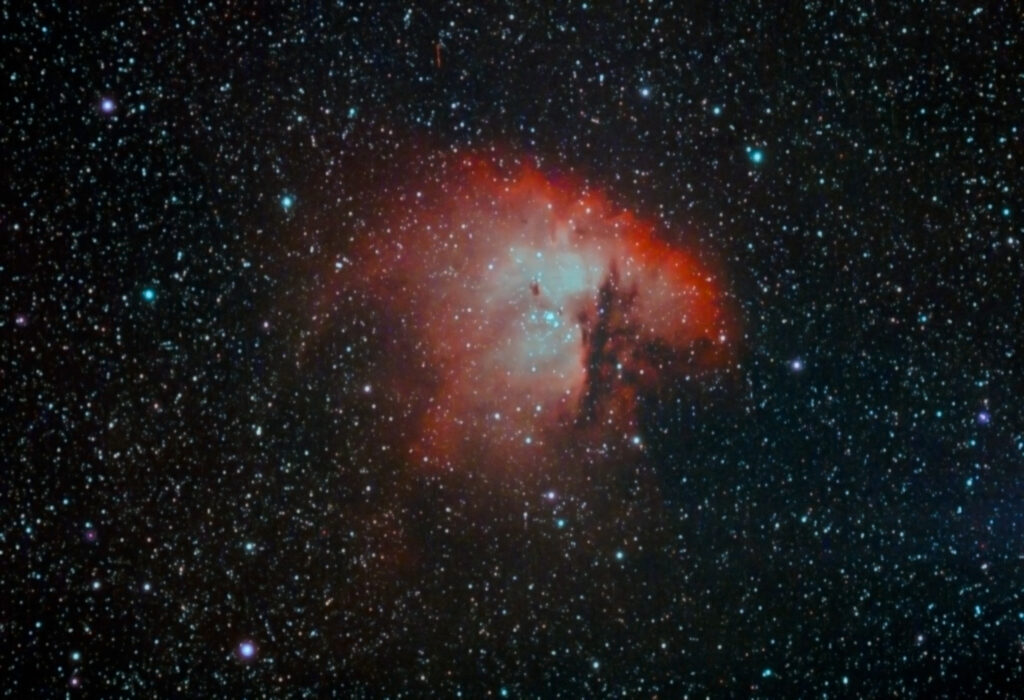Nebulae

IC 405
The Flaming Star Nebula
An emission and reflection nebula in the constellation Auriga north of the celestial equator, surrounding the bluish, irregular variable star AE Aurigae. It shines at magnitude +6.0.
7th January 2024

M27 / NGC 6853
The Dumbbell Nebula
The Dumbbell Nebula is a planetary nebula in the constellation Vulpecula, at a distance of about 1360 light-years, and has a radius of 1.44 light years. It was the first such nebula to be discovered, by Charles Messier in 1764.
2nd September 2023

NGC 7365
The Bubble Nebula
NGC 7635, also known as the Bubble Nebula, Sharpless 162, or Caldwell 11, is an H II region emission nebula in the constellation Cassiopeia. It lies close to the open cluster Messier 52. The “bubble” is created by the stellar wind from a massive hot, 8.7 magnitude young central star, SAO 20575.
2nd September 2023

IC 1396
Elephant’s Trunk Nebula
A concentration of interstellar gas and dust within the much larger ionized gas region IC 1396 located in the constellation Cepheus about 2,400 light years away from Earth.
9th August 2023

IC 443
The Jellyfish Nebula
A galactic supernova remnant in the constellation Gemini. On the plane of the sky, it is located near the star Eta Geminorum. Its distance is roughly 5,000 light years from Earth. IC 443 may be the remains of a supernova that occurred 3,000 – 30,000 years ago.
20th January 2023

NGC 2023
The Horsehead Nebula
A small dark nebula in the constellation Orion and is 1,500 light years away from us. The nebula is located just to the south of Alnitak, the easternmost star of Orion’s Belt, and is part of the much larger Orion Molecular Cloud Complex.
15th January 2023

IC 1805
The Heart Nebula
The Heart Nebula, IC 1805, Sharpless 2-190, is some 7500 light years away from Earth and is located in the Perseus Arm of the Galaxy in the constellation Cassiopeia. It was discovered by William Herschel on 3 November 1787. It is an emission nebula showing glowing ionized hydrogen gas and darker dust lanes.
23rd November 2021

NGC 6960
The Western Veil Nebula
Also known as the Witch’s Broom Nebula, and Sharpless 103, is the remnant from a supernova which occurred about 10,000 years ago. It’s the counterpart to the Eastern Veil Nebula, NGC 6992. Its amazing filamentary structure is thought to be due to compression of expanding shells of gas as they meet the resistance of the interstellar medium.
6th September 2021

NGC 6979
The Eastern Veil Nebula
The Veil Nebula is a cloud of heated and ionized gas and dust in the constellation Cygnus. It constitutes the visible portions of the Cygnus Loop, a supernova remnant, many portions of which have acquired their own individual names and catalogue identifiers.
28th August 2021

NGC 6888
The Crescent Nebula
The Crescent Nebula is an emission nebula in the constellation Cygnus, about 5000 light-years away from Earth. It was discovered by William Herschel in 1792.
14th June 2021

M16
The Eagle Nebula
The Eagle Nebula is a young open cluster of stars in the constellation Serpens, discovered by Jean-Philippe de Cheseaux in 1745–46, and contains the Pillars of Creation famously captured by Hubble.
13th June 2021

NGC 2359
Thors Helmet Nebula
NGC 2359 is an emission nebula in the constellation Canis Major. The nebula is approximately 3,670 parsecs away and 30 light-years in size. The central star is the Wolf-Rayet star WR7, an extremely hot star thought to be in a brief pre-supernova stage of evolution.
18th March 2021

NGC 2359
The Rosette Nebula
The Rosette Nebula is an H II region located near one end of a giant molecular cloud in the Monoceros region of the Milky Way Galaxy. The open cluster NGC 2244 is closely associated with the nebulosity, the stars of the cluster having been formed from the nebula’s matter.
8th March 2021

NGC 281
The Pacman Nebula
NGC 281, IC 11 or Sh2-184 is a bright emission nebula and part of an H II region in the northern constellation of Cassiopeia and is part of the Milky Way’s Perseus Spiral Arm. This 20×30 arcmin sized nebulosity is also associated with open cluster IC 1590, several Bok globules and the multiple star, B 1.
24th January 2021

NGC 7000
North America Nebula
The North America Nebula is an emission nebula in the constellation Cygnus, close to Deneb.
In 1890, the pioneering German astrophotographer Max Wolf noticed this nebula’s characteristic shape on a long-exposure photograph, and dubbed it the North America Nebula.
28th December 2020

M42
The Orion Nebula
The Orion Nebula is a diffuse nebula situated in the Milky Way, being south of Orion’s Belt in the constellation of Orion, and is known as the middle “star” in the “sword” of Orion. It is one of the brightest nebulae and is visible to the naked eye in the night sky with apparent magnitude 4.0.





